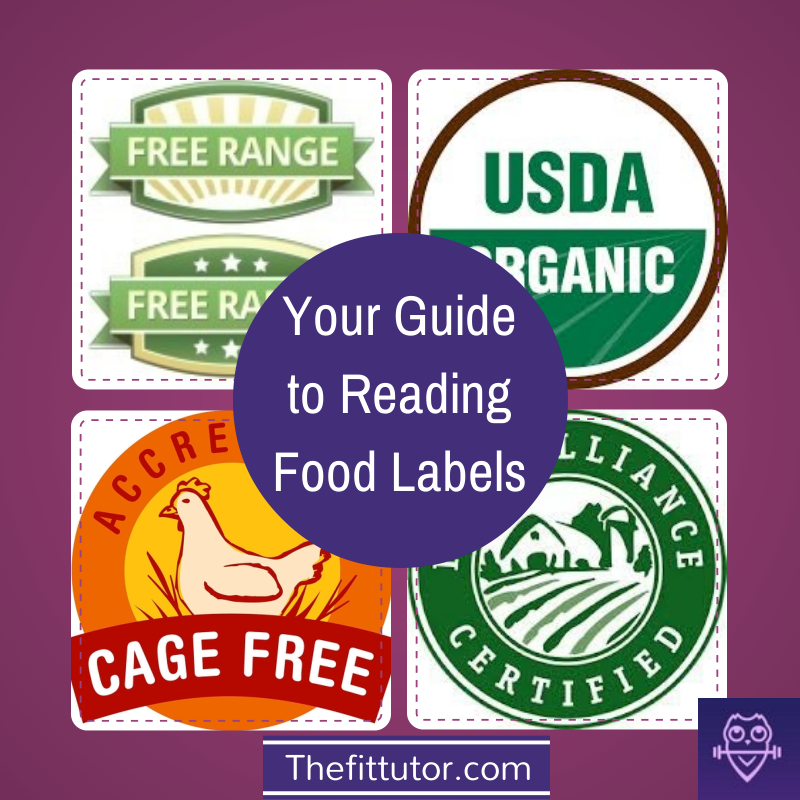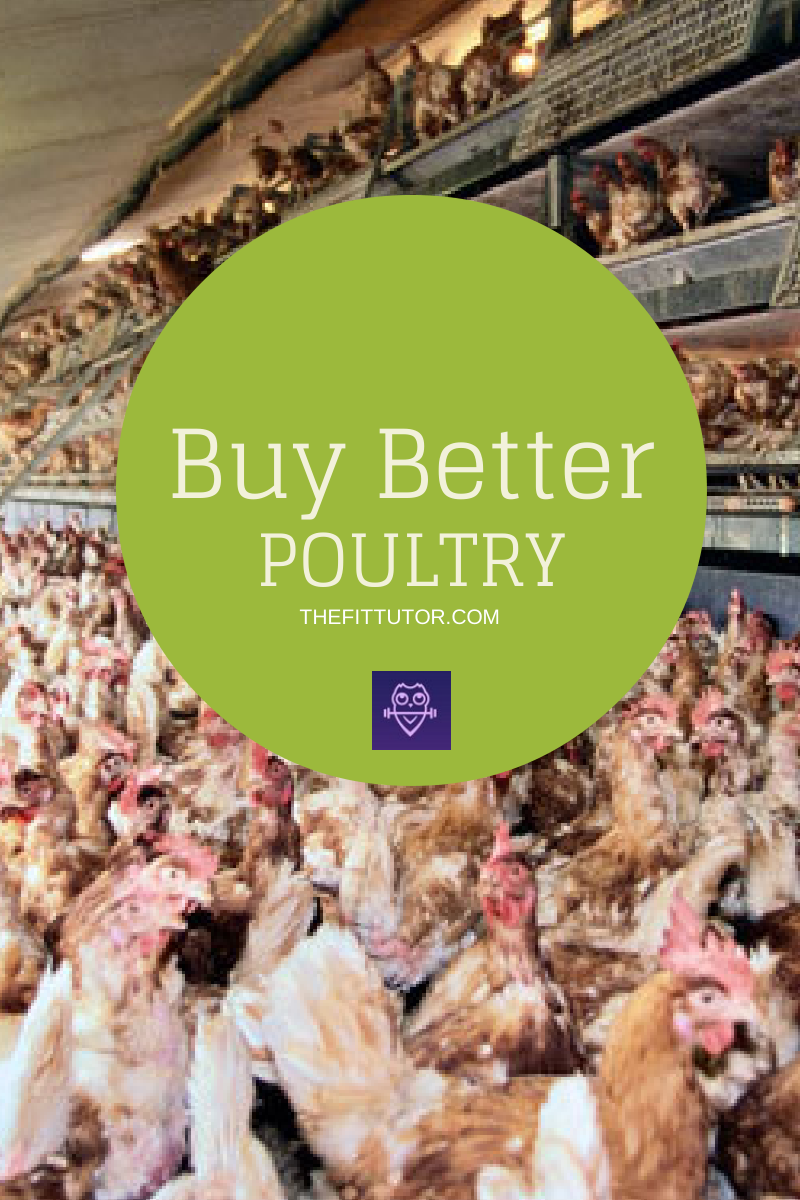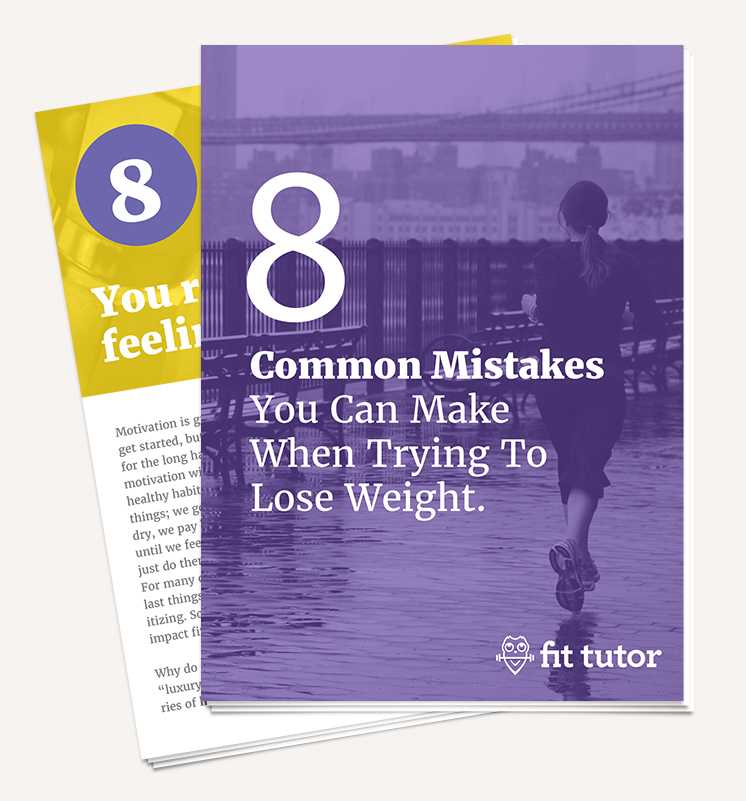If you want to detox your life, you want to avoid consuming chemicals then buy better poultry. These chemicals not only can contribute to cancer or other diseases, but also mess with your hormones and weight! This month we’ll zero in on buying chemical-free birds! If you’re not interested in detoxing but are an animal lover, then you will want to check out our label guide!
I’d love to hear how things are going with your other detox “assignments” like lemon water, washing veggies, and buying better dairy! Leave me updates in the comments! As always, post any questions you may have or brands/tips that have worked for you on your path to detoxing!
The journey to buying better poultry can seem a little overwhelming because there are a lot of labels to understand and claims to see through. Let’s start with deciphering these labels.
Buying Better Poultry: Label Guide
Organic:
To get certified as Organic, the farm has to meet USDA standards. These include 100% organic feed (including pesticide free and no GMO’s), no antibiotics, access to the outdoors, no irradiation, no sewage sludge (yeah, seriously…) and no synthetic pesticides.
100% Vegetarian Fed:
This label means the poultry feed contained grains and grasses, but no animal byproducts (which can include feces and ground up animal parts, yummm). It does not guarantee their feed was pesticide-free or non-GMO.
Antibiotic-Free (or anything similar):
Antibiotics are administered for a variety of reasons, such as preventing disease (so, yes, they are given to healthy animals), treating disease, increasing feed efficiency, and to stimulate growth. They are put in food and/or administered directly to the animal. There’s worry that pumping these animals full of antibiotics is creating strains of drug-resistant bacteria, as well as polluting our waterways with the runoff from farms. An antibiotic-free label means the animals were not administered any antibiotics, and sick animals were removed from the herd. You may also see “raised without the routine use of antibiotics.” This means they were only used to treat sick animals and not for preventative measures.
Raised Without Hormones:
If you find this label on poultry, you should see a disclaimer that it’s illegal to treat poultry with hormones. Make sure you don’t pay more for a label like this- it means nothing! This label does matter for cows, but we’ll get to that in another blog, or refresh your memory from our dairy post!
Pesticide-Free:
This label ensures the feed AND the chicken houses were not sprayed with pesticides. Chicken houses, especially on industrial farms, can be infested with rodents and lice and are often sprayed down with insecticides. This doesn’t guarantee there wasn’t pesticide residue, though. Read more about the link between pesticides and cancer here.
Natural:
Last month we discussed the joke that is the “all natural” label. I’ll expand on it by saying it disallows the use of artificial colors, flavors, and preservatives, and allows only “minimal processing.” Any unflavored meat would qualify as “natural.”
Free-Range/Free Roaming:
I’m sad to say this label had me fooled. I knew it was theoretically good and always looked for it, but when researching the requirements for “free-range” I was seriously let down. According to USDA guidelines, to qualify for the free-range label, the birds need to have outdoor access for 5 minutes a day. “Outdoor” doesn’t mean grass or dirt to perform normal bird-like activities, either. Unfortunately concrete and artificial lighting count as the great outdoors. Free-range means the birds weren’t raised in cages, but it still allows for overcrowded conditions on industrial farms.
Cage-Free:
This is an equally disappointing label because although the bird was not caged, it could still have lived in overcrowded conditions in a floor system. Hens are given bedding material and allowed perches and nest boxes to lay eggs. This is better than battery cages, but cage-free doesn’t equal cruelty-free. If cage-free matters to you, check for the humane treatment labels described below.
[Mini-Lesson on Humane Certifications:]
To assure your birds truly were “free-range” or “cage-free” you need to also look for the Animal Welfare Approval label. This is the gold standard for animal welfare. It ensures:
- birds can nest, perch, and spread their wings
- required outdoor access with a specific quality/duration
- beak cutting and forced molting are prohibited
- birds must be in a stress-free environment.
Not only is this good if you care about animal welfare, but research shows that the birds are more nutritional for us.
The Certified Humane Label requires the ability to perch, nest, and spread their wings, and also forbids forced molting (but allows beak cutting). Specifically “free range” birds are required outdoor access for at least 8 hours a day.
The Food Alliance Certified label requires ability to perch, nest, and spread their wings, forbids forced molting (but allows beak cutting), and the birds are cage-free and given daily outdoor access.
The American Humane Certified label is not as strict and still allows inhumane conditions for poultry, so opt for the others if you have the choice.
These third party labels cost money, so your local farmer might not have them. Many will give farm tours and share their practices with you if you ask. They may have rigid standards, even if they haven’t paid for third party certifications.
Buying better poultry guide:
Now that we’re through all of the complicated food labels, let’s talk about purchasing. I know this is long, so you should pin this or save it for later!
Chicken
This is one thing I always buy organic. If they don’t have organic, I buy a different meat or eat vegetarian. Remember, if it’s organic, it’s pesticide and antibiotic-free, too. If your current grocery budget doesn’t support organic, the next best would be an antibiotic-free bird.
In an ideal world, you would be able to buy Pastured or Heritage chicken, but at most grocery chains these are (expensive! and) hard to find. Pastured means the birds lived in an actual pastured environment, and their meat has more vitamin E, folic acid, B-12, and Omega-3’s than the average chicken.
Here are some brands I recommend:
- Smart Chicken (no antibiotics or animal byproducts) and Smart Chicken Organics (which are actually free-range, check out their story) are the only options I have at my local grocery chain.
- Mary’s Chickens– certified Organic, Non-GMO, and have enhanced outdoor access (at Whole Foods)
- Bell & Evan’s Chicken– offers organic and/or antibiotic-free chickens, and it seems their free-range birds are really free-range (at Whole Foods).
- I also buy Earth Fare’s chicken. Even though it’s not certified organic, it’s antibiotic-free and humanely raised.
- I hear Costco has good prices for organic meat, including Coleman Organics, but alas, I am still slacking on getting my membership! D’oh!
- I am lucky to not shop frequently at Wal-Mart, but according to their website they carry a line of organic, cage-free chicken called Blackwing Quality Meats (which you can also buy online). I’ve bought Harvestland Chicken there, which offers organic and free-range chicken.
- Remember to really read labels at Trader Joe’s. There meat isn’t always what it seems- read more here from The Food Babe.
Eggs.
First off, let’s set the record straight on egg yolks. They are good for you. Seriously, read this article and scroll down to #10. It’s worth it. Then start eating eggs, and not processed egg beaters!
When buying eggs, there’s no better choice than a local farmer. Buy at your farmers market, or maybe a friend or neighbor who raises their own chickens. You can ask about their feed, pesticide and antibiotic use, and there’s a much greater chance that if they say “free-range” or “cage-free” the animals actually had access to land! Those eggs will be more yellow/orange, fresh, and higher in important nutrients. [See the links below for help finding a local farmer!]
If the farmer’s market isn’t an option, I recommend buying organic eggs. Don’t think the eggs are somehow immune to the antibiotics, sewage sludge, and pesticides. I usually buy organic free-rage or cage-free with third party certifications. I personally believe it’s worth the money, because I’m supporting farms with good and healthy practices, but I would prefer to support my local farmer. Don’t feel guilty if that’s not in your budget. I try to vote with my money when I have the chance!
Brands, both good and bad:
- I don’t recommend Eggland’s Best or Land O’ Lakes, but if price is your main concern these are usually a little bit cheaper for an organic egg. They still have overcrowded factory farms…
- Another major brand is Born Free, and when I buy eggs at my local grocery store I usually opt for this brand. They have good practices, are Certified Humane, and have cage-free, free-roaming, and organic options.
- Organic Valley is another good brand you should find in most grocery stores, and choose these over Horizon Organic if you have the option (click the links to find out why!).
This is certainly something where you need to just read labels, look for the price that fits your budget, and make your own choice. You can check out where your eggs actually come from by reading the farm’s website and what others have to say about them! :)
Turkey.
I give the same advice for buying turkey as I do chicken- buy organic if at all possible, and if you can’t then shoot for an antibiotic-free turkey. I buy Organic Prairie ground turkey at Harris Teeter, and stock up at Earth Fare whenever I have the chance! The Blackwing Meats and Harvestland Brand at Wal-Mart also produces organic, free-range turkeys. Mary’s also raises organic turkeys, and Costco offers a brand as well. Now that you can decipher these labels, choosing the best turkey should be easy!
Check out my pinterest boards for recipes to make with your healthy meat: Chicken Dishes, Paleo, Breakfast, and Healthy Recipes.
Sources/Further Reading:
Local Dairy Resources:
- Local Harvest– use this to find CSA’s, local farms, restaurants serving local food, etc
- Eat Wild – find a local free-range, organic farm
- Eat Local Grown
- Farmstand App – see who’s coming to your local farmer’s market!
- Search for your own local Farmer’s Market Delivery service or CSA pick-up. Here in NC I have loved using Backyard Produce and The Produce Box
Money Saving Articles: Buying Organic
- The Food Babe- Money Saving Tips
- Babble- 8 Ways to Save Money on Organic Meats
- Money Saving Mom- How we Afford to Eat Organic Foods on a $100/week Grocery Budget
Chicken:
- Consumer Reports- The High Cost of Cheap Chicken
- Consumer Reports: Guide (very specific) to Labels
- Mark’s Daily Apple- Guide to Buying Chicken
- Grist- Arsenic in Chicken Feed
- Penn State News- Pasturized Poultry is Healthier
Eggs:
- Cornucopia Institute Video: Scrambled Eggs
- Food Renegade: How to Buy Healthy Eggs
- Rodale News: Organic Eggs Are Worth the Splurge
- Mark’s Daily Apple- Egg Buying Guide
Turkey
- NPR- Antibiotic Resistant Drugs Turn Up Again in Turkey
- Consumer Reports: Bacteria in Turkey Meat
- FoodSafety.Org- Antibiotic-free Turkey Less Likely to Contain Antibiotic Resistant Bacteria




KUDOS TO ALLISON,
YOUR THOROUGH RESEARCH, AND LIFE EXPERIENCE HAVE MADE THIS ANALYSIS ONE OF THE BEST I HAVE EVER READ!!